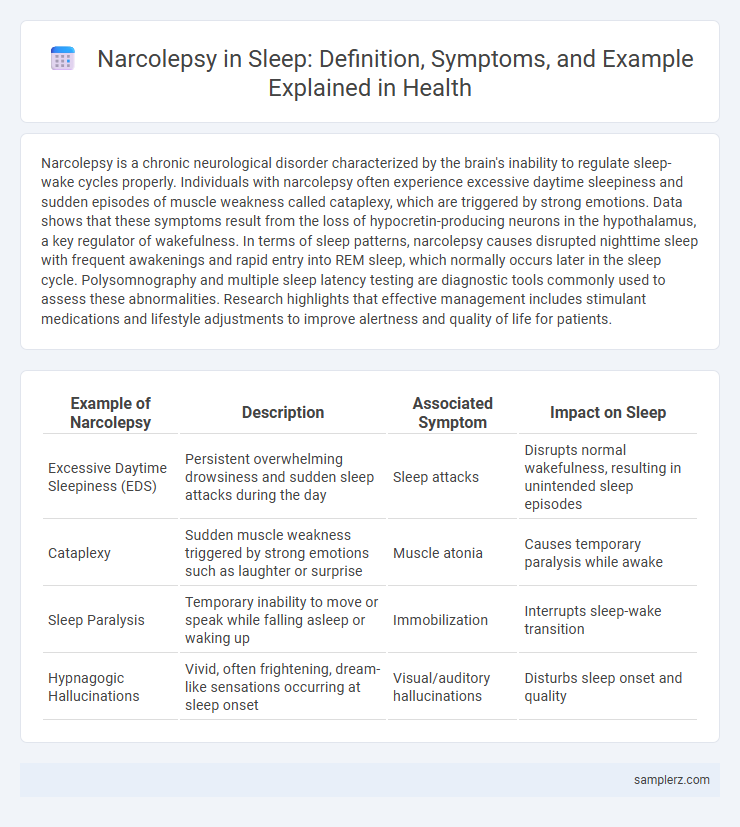Narcolepsy is a chronic neurological disorder characterized by the brain's inability to regulate sleep-wake cycles properly. Individuals with narcolepsy often experience excessive daytime sleepiness and sudden episodes of muscle weakness called cataplexy, which are triggered by strong emotions. Data shows that these symptoms result from the loss of hypocretin-producing neurons in the hypothalamus, a key regulator of wakefulness. In terms of sleep patterns, narcolepsy causes disrupted nighttime sleep with frequent awakenings and rapid entry into REM sleep, which normally occurs later in the sleep cycle. Polysomnography and multiple sleep latency testing are diagnostic tools commonly used to assess these abnormalities. Research highlights that effective management includes stimulant medications and lifestyle adjustments to improve alertness and quality of life for patients.
Table of Comparison
| Example of Narcolepsy | Description | Associated Symptom | Impact on Sleep |
|---|---|---|---|
| Excessive Daytime Sleepiness (EDS) | Persistent overwhelming drowsiness and sudden sleep attacks during the day | Sleep attacks | Disrupts normal wakefulness, resulting in unintended sleep episodes |
| Cataplexy | Sudden muscle weakness triggered by strong emotions such as laughter or surprise | Muscle atonia | Causes temporary paralysis while awake |
| Sleep Paralysis | Temporary inability to move or speak while falling asleep or waking up | Immobilization | Interrupts sleep-wake transition |
| Hypnagogic Hallucinations | Vivid, often frightening, dream-like sensations occurring at sleep onset | Visual/auditory hallucinations | Disturbs sleep onset and quality |
Understanding Narcolepsy: Definition and Symptoms
Narcolepsy is a chronic neurological disorder characterized by the brain's inability to regulate sleep-wake cycles normally, leading to excessive daytime sleepiness and sudden sleep attacks. Key symptoms include cataplexy, a sudden loss of muscle tone triggered by strong emotions, sleep paralysis, and hallucinations during sleep transitions. This condition disrupts nighttime sleep and affects daily functioning, requiring proper diagnosis and management to improve quality of life.
Common Real-Life Examples of Narcolepsy
Narcolepsy often manifests through sudden episodes of excessive daytime sleepiness, causing individuals to involuntarily fall asleep during activities such as driving, working, or having conversations. Cataplexy, a sudden loss of muscle tone triggered by strong emotions like laughter or surprise, is another common symptom experienced in real-life scenarios. Frequent sleep paralysis and vivid hallucinations during sleep-wake transitions further illustrate the daily challenges faced by those with narcolepsy.
Case Study: Narcolepsy During Work Hours
A 35-year-old software engineer experienced sudden, uncontrollable sleep attacks during office hours, causing frequent disruptions and decreased productivity. Polysomnography and multiple sleep latency tests confirmed narcolepsy with cataplexy, necessitating tailored treatment including modafinil and scheduled naps. Workplace accommodations, such as flexible scheduling and rest breaks, improved alertness and overall job performance.
Narcolepsy in Students: Classroom Incidents
Narcolepsy in students often leads to sudden daytime sleep attacks, causing them to fall asleep unexpectedly during lessons. These incidents can disrupt classroom activities and hinder academic performance, especially when accompanied by cataplexy or sleep paralysis. Teachers and peers may need awareness and accommodations to support affected students effectively.
Everyday Situations Triggering Narcoleptic Episodes
Narcoleptic episodes often occur during everyday situations such as monotonous activities, sudden emotional changes, or periods of inactivity, like sitting through meetings or watching television. Stress and fatigue increase the likelihood of sleep attacks, with triggers including laughter, surprise, or physical exertion. Understanding these common triggers helps individuals manage their condition and implement safety measures in daily routines.
Narcolepsy and Driving: Risks and Examples
Narcolepsy significantly impairs driving ability due to sudden daytime sleep attacks and severe cataplexy, increasing the risk of accidents. Studies show individuals with narcolepsy have a higher incidence of vehicular crashes caused by unexpected sleep episodes. Safety measures include regular medical evaluations, medication adherence, and avoiding driving during high-risk periods to reduce fatal outcomes.
Impact of Narcolepsy on Social Activities
Narcolepsy significantly disrupts social activities due to sudden daytime sleep attacks that cause loss of alertness and communication difficulties. People with narcolepsy often experience social isolation and decreased participation in group events because excessive daytime sleepiness impairs their ability to stay engaged. Managing symptoms with medication and lifestyle adjustments can improve social interaction and overall quality of life.
Recognizing Narcoleptic Episodes at Home
Narcoleptic episodes often manifest as sudden muscle weakness known as cataplexy, excessive daytime sleepiness, and brief episodes of sleep paralysis or hallucinations. Caregivers and family members should monitor for abrupt onset of uncontrollable sleep attacks occurring during daily activities, which can significantly impair coordination and safety. Accurate recognition of these symptoms at home is essential for timely medical consultation and management of narcolepsy.
Managing Sudden Sleep Attacks in Public Spaces
Managing sudden sleep attacks in public spaces requires immediate safety measures, such as sitting or lying down to prevent injury. Using alert devices like wristbands that notify nearby individuals or carrying a medical ID can help communicate the condition effectively. Implementing scheduled naps and stimulant medications as prescribed by a healthcare professional can reduce the frequency and severity of these episodes.
Real Patient Narratives: Living with Narcolepsy
Real patient narratives reveal the relentless impact of narcolepsy on daily life, highlighting symptoms like sudden sleep attacks, excessive daytime sleepiness, and cataplexy triggered by strong emotions. Many patients describe the challenge of managing unpredictable sleep episodes in work and social settings, often leading to feelings of isolation and frustration. These firsthand accounts emphasize the urgent need for tailored treatment plans and increased awareness to improve quality of life for those living with narcolepsy.

example of narcolepsy in sleep Infographic
 samplerz.com
samplerz.com